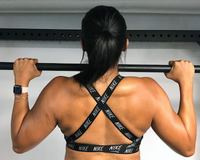
The curtsy lunge is one of the best lunge variations that activates the glutes, making it a great way to sculpt your butt! It can be performed at the gym or in the comfort of your own home.
The curtsy lunge is an extremely versatile and effective exercise to add to your lower body routine. It is one of the best lunges for glutes.
Muscles Worked by the Curtsy Lunge
Primary Muscle Groups:
The curtsy lunge primarily engages the quadriceps and the glutes. The rectus femoris, vastus intermedius, vastus medialis, and the vastus lateralis make up the four muscles of the quadriceps in the front of your leg.
This exercise places significant tension on this group of four muscles and in turn, increases hypertrophy and explosiveness of the quadriceps.

The gluteus maximus, medius, and minimus make up the three gluteal muscles. Like all other lunging motions, the curtsy lunge activates the glutes.
However, the curtsy lunge engages the gluteus medius and minimus more than other lunges. This will help to shape the gluteus and strengthen it as a cohesive unit.

Secondary Muscle Groups:
In addition, the curtsy lunge engages the calves. Comprised of the soleus and the gastrocnemius, the calves activate at the bottom of each lunge as you thrust upwards.
As a result, while the quads and glutes receive most of the tension during the curtsy lunge, the calves also play a role in the exercise.

Curtsy Lunge Benefits
1. Stronger Legs and Glutes
The curtsy lunge will build serious lower body strength. Because the cross-legged nature of the motion may seem a bit foreign at first, this exercise can be a smart way to mix up your lower body workouts.
For those trying to increase their maximum deadlift or squat, the curtsy lunge can serve as a great supplementary exercise.
On the other hand, for those of you who play sports such as hockey or figure skating, this motion will feel familiar.
If this is the case, the curtsy lunge will only strengthen your lower body for better performance in your sport.
2. Sculpted Glutes
As stated before, most lower body exercises primarily engage the gluteus maximus, the largest of the gluteal muscles. Yet, the curtsy lunge also targets the gluteus medius and minimus.
Therefore this exercise will help to give your butt a balanced, well-rounded appearance.
3. Improved Balance
As you cross your leg behind you, muscles in your ankle, calves, quads, and core all work to stabilize your body during the curtsy lunge. This will help improve your body control. For an even harder challenge, practice completing each repetition in slow-motion.
You will feel a greater muscle activation and a heightened connection between your mind and body, which is an important skill involved in balancing.
How to Do the Curtsy Lunge
Equipment:
To perform the curtsy lunge, all you need is your body weight. See the variations below for different challenges!
Setup:
a) Start from a standing position with your chest held high and your back straight.
Action:
a) With your left foot straight in front of you, step with your right foot back and to the left. Both of your knees will bend and your legs will be “crossed.” Make sure your left knee is directly over your left ankle. At this point, you will look like you are doing a curtsy!
b) Next, drive upwards in a controlled fashion to the standing position.
c) Repeat this motion with your right foot out in front. You can switch legs after each repetition or after each set.

Recommendation:
The curtsy lunge can be tricky at first. With practice, you will be able to balance well on each rep. Perform 3-4 sets of 12-15 repetitions. If you are using heavier weight, do 6-8 repetitions per set.
Curtsy Lunge Mistakes
1. Leaning Too Far Forward
If your front knee extends over your front ankle, this is one indication that you are leaning too far forward during the curtsy lunge. If this happens, you are placing too much tension on your knee and quadriceps.
Every curtsy lunge should place a strong emphasis on the glutes as well. Make sure your front knee aligns with your ankle for proper weight distribution.
2. Leaning Too Far Back
Some people make the opposite mistake when performing the curtsy lunge — their front knee extends too far behind the front ankle. In this case, too much weight is on your back foot and the quadriceps is not activated to its full potential.
Your weight distribution is crucial in this exercise, not only for proper form but also for improving your balance.
3. Opening Up the Hips
Many people tend to allow their hips to open up in one direction during the curtsy lunge. While one of your legs does cross the other, you want to be sure that your hips remain square out in front of you.
This will ensure proper form and optimum balance during the exercise motion.
Curtsy Lunge Variations
1. Curtsy Lunge with Dumbbells
If you feel comfortable with the form of the curtsy lunge, try adding dumbbells. This will challenge your muscles with added physical tension. It will also provide an isometric forearm workout!

2. Curtsy Lunge with Kettlebell
Similar to the dumbbells, the kettlebell variation of the curtsy lunge will add more tension to the lower body. However, holding a kettlebell out in front of you also engages the core muscles.

Curtsy Lunge Alternatives
If you enjoyed the curtsy lunge, check out these other leg and glute exercises to improve your lower body training:
1. Fire Hydrants
Assume a starting position on all fours with your hands directly under your shoulders. Keeping your leg bent, lift one leg out to the side, stopping at hip-height.
Squeeze your glutes and return to the starting position. Repeat!

2. Side Lunge (kettlebell optional)
Assume a standing position with your toes slightly flared out and your feet wider than shoulder width apart. Keeping your left leg straight, bend your right knee and shift your weight to your right side.
Then, transition to the starting position and repeat on the left side. Keep switching legs!

3. Alternating Reverse Lunge
Start from a standing position with your feet roughly hip width apart, your chest held high, and your back straight.
With your left foot straight in front of you, step back with your right foot and lunge down until your right knee touches the ground. In this position, your left knee should be directly over your left ankle.
Next, drive upwards in a controlled fashion to the standing position. Repeat this motion for your desired number of reps as you alternate lunges on both sides.

Looking For A Full Glute Workout?
Check out this intense 5 minute hip & glute workout!
Join the Invasion!
This Anabolic Aliens membership will grant you access to workout classes, rehab programs, diet plans, and more exclusive content to help you achieve sustainable success!










